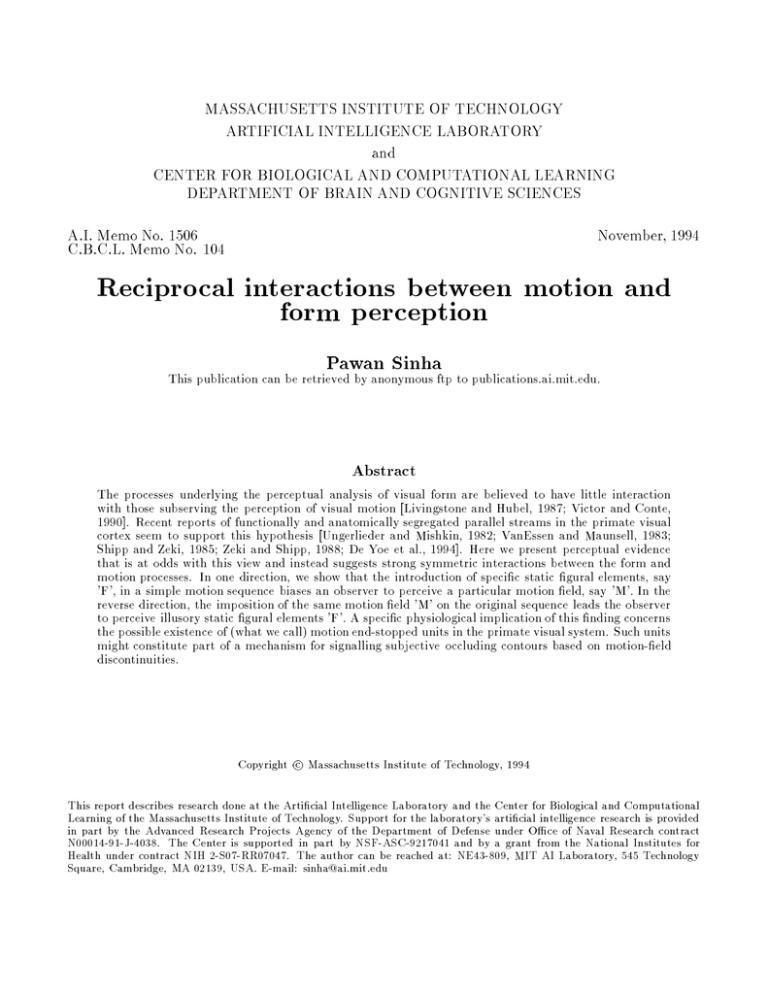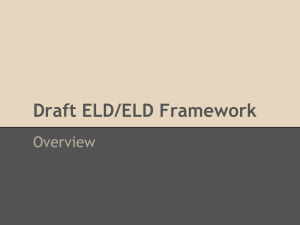MASSACHUSETTS INSTITUTE OF TECHNOLOGY ARTIFICIAL INTELLIGENCE LABORATORY and
advertisement

MASSACHUSETTS INSTITUTE OF TECHNOLOGY
ARTIFICIAL INTELLIGENCE LABORATORY
and
CENTER FOR BIOLOGICAL AND COMPUTATIONAL LEARNING
DEPARTMENT OF BRAIN AND COGNITIVE SCIENCES
A.I. Memo No. 1506
C.B.C.L. Memo No. 104
November, 1994
Reciprocal interactions between motion and
form perception
Pawan Sinha
This publication can be retrieved by anonymous ftp to publications.ai.mit.edu.
Abstract
The processes underlying the perceptual analysis of visual form are believed to have little interaction
with those subserving the perception of visual motion [Livingstone and Hubel, 1987; Victor and Conte,
1990]. Recent reports of functionally and anatomically segregated parallel streams in the primate visual
cortex seem to support this hypothesis [Ungerlieder and Mishkin, 1982; VanEssen and Maunsell, 1983;
Shipp and Zeki, 1985; Zeki and Shipp, 1988; De Yoe et al., 1994]. Here we present perceptual evidence
that is at odds with this view and instead suggests strong symmetric interactions between the form and
motion processes. In one direction, we show that the introduction of specic static gural elements, say
'F', in a simple motion sequence biases an observer to perceive a particular motion eld, say 'M'. In the
reverse direction, the imposition of the same motion eld 'M' on the original sequence leads the observer
to perceive illusory static gural elements 'F'. A specic physiological implication of this nding concerns
the possible existence of (what we call) motion end-stopped units in the primate visual system. Such units
might constitute part of a mechanism for signalling subjective occluding contours based on motion-eld
discontinuities.
c Massachusetts Institute of Technology, 1994
Copyright This report describes research done at the Articial Intelligence Laboratory and the Center for Biological and Computational
Learning of the Massachusetts Institute of Technology. Support for the laboratory's articial intelligence research is provided
in part by the Advanced Research Projects Agency of the Department of Defense under Oce of Naval Research contract
N00014-91-J-4038. The Center is supported in part by NSF-ASC-9217041 and by a grant from the National Institutes for
Health under contract NIH 2-S07-RR07047. The author can be reached at: NE43-809, MIT AI Laboratory, 545 Technology
Square, Cambridge, MA 02139, USA. E-mail: sinha@ai.mit.edu
1 Introduction
Our claim of strong reciprocal interactions between the
analyses of two-dimensional visual form and motion rests
on the demonstration that for a large class of simple motion sequences, changes in the perceived static 2D gural
elements can cause, and be caused by, modications in
the perceived 2D motion-eld. The motion sequences
we use are two-dimensional animations comprising of
simple geometric gures translating under stationary occluding patches. These patches obscure the moving gures' vertices. Figure 1(b) shows a typical sequence (for
ease of exposition, we shall work exclusively with this
sequence (call it sequence 'A') in this paper). It was
created by moving a diamond shaped wireframe horizontally back and forth under three stationary vertical
occluders (gure 1(a)). The diamond's extent of translation was limited to ensure that none of its vertices were
ever visible. The occluding strips were assigned exactly
the same gray-level as the background, thereby rendering
their boundaries invisible.
pects of sequence 'A' could eect its motion percept.
The second set examined the possibility of a reciprocal
inuence - a change in sequence 'A's perceived motion
eld inuencing its perceived gural content.
2 Experiment 1: The inuence of form
on motion
2.1 Methods:
Our subjects were ve MIT graduate students, naive as
to the purpose of the experiment. The experiment had
two parts. In part one, the subjects were individually
shown ten presentations (each lasting 5 seconds) of sequence 'A'. They were instructed to verbally report, after
each presentation, the dominant direction of perceived
motion (horizontal, diagonal or vertical).
For part two of the experiment, we created a new
sequence (sequence 'B') by modifying sequence 'A' to
explicitly suggest the presence of the occluding strips
(gure2(a)). The presentation schedule for part one was
repeated with sequence 'B'.
2.2 Results and Discussion:
(a)
(b)
Figure 1: (a) The setup used in our experiments. (There
is no physical signicance to the absolute depth dierences between the occluders, diamond and background
shown in this gure. They are indicative only of the
depth ordering used to generate the 2D motion sequences.) We used the Macromind Director software
package running on a Macintosh Quadra 700 to generate the sequences. The sequences were presented on
a 16" monochrome monitor and subtended 7 degrees of
visual angle at a viewing distance of 80 cm. The diamond's speed of oscillation was 0.7 degrees per second.
(b) Three frames from sequence 'A': the diamond oscillating horizontally behind occluders that have exactly the
same gray-level as the background.
We performed two sets of experiments. The rst set
was designed to study how a change in the gural as-
Figure 2(b) summarizes the dierent results obtained
with sequences 'A' and 'B'. The dominant percept for all
subjects with sequence 'A' was that of vertical oscillatory
motion (gure 3(a)) while sequence 'B' was perceived as
having motion in the horizontal direction (gure 3(b)).
It is important to note that the raw motion signals in
sequences 'A' and 'B' are identical; the changes in perceived motion can therefore be justiably attributed simply to the dierences in the static gural contents of the
two sequences.
Precisely how might the visibility of the strips in sequence 'B' inuence the analysis of motion? There are
at least two possibilities: First, with the strips visible,
the line terminations are interpreted as arising out of
occlusion rather than as intrinsic features of the moving
lines. This induces the visual system to discard their
vertical motion [Shimojo et al., 1989; Shirar and Pavel,
1991; Lorenceau and Shirar, 1992]. The only intrinsic
motion signals now available are those from the interiors of the line segments. However, these motion signals
are inherently ambiguous due to the aperture problem
[Hildreth, 1984; Poggio et al. 1985]: for each line segment, only the component of motion perpendicular to its
orientation can be recovered. Second, by suggesting the
possibility of the line-segments continuing behind them,
the strips allow amodal grouping of the segments and the
consequent integration of their motion signals, possibly
by the intersection of constraints construction [Movshon
et al. 1985]. The resultant motion is in the horizontal
direction.
The net eect is that instead of seeing four independent line-segments moving vertically, the observer now
perceives them as moving coherently in the horizontal direction. A change in the gural content of sequence 'A'
thus leads to a change in the perceived motion (gure
1 4(a)).
3.2 Results and Discussion:
Figure 6(a) summarizes the dierent results obtained
with sequences 'A' and 'C'. The subjects reported perceiving strong illusory contours [Petry and Meyer, 1987]
in nearly all presentations of sequence 'C' but not in sequence 'A'. The responses of all subjects were in agreement regarding the locations of the perceived contours.
The contours were seen as delimiting illusory occluding
strips at the locations indicated in gure 6(b). Any single
static frame from this sequence did not aord the percept
of subjective contours. Interestingly, on subsequent presentations of sequence 'A', four of the subjects reported
being able to perceive subjective occluding boundaries
simply by mentally imposing a horizontal motion eld on
the sequence; the subjective contours disappeared when
the four line segments were seen as moving vertically. In
essence, then, changes in the motion eld, whether imposed externally or internally via top-down mechanisms,
profoundly inuenced the perceived gural content for
our subjects.
2
100%
Our subjects for this experiment were ve naive MIT
graduate students, dierent from the ones who had participated in experiment 1. This was done to prevent
an inuence of any experientially acquired biases from
experiment 1 on the subjects' performance. The experiment had two parts. In part one, the subjects were
individually shown ten presentations (each lasting 5 seconds) of sequence 'A'. They were instructed to indicate
with a cursor on the display, after each presentation, the
locations of any perceived subjective contours.
For part two of the experiment, we created a new
sequence (sequence 'C') by 'imposing' a horizontal motion eld on sequence 'A'. This was done by attaching
to the diamond's contour point-features moving unambiguously in the horizontal direction (gures 5(a) and
5(b)). The point features were so placed as to never be
obscured by occluders. The presentation schedule for
part one was repeated with sequence 'C'.
Horizontal motion
perceived
Proportion of presentations
3.1 Methods:
Vertical motion
perceived
Sequence 'A'
PRL
UM
SR
KKS
JBL
Vertical motion
perceived
Sequence 'B'
Horizontal motion
perceived
100%
3 Experiment 2: The inuence of
motion on form
(a)
Proportion of presentations
The preceding demonstration of the inuence of form
on perceived motion is not entirely new. Somewhat similar eects have been reported earlier, though, to the best
of our knowledge, this is the rst demonstration of subjective static gural elements exerting an inuence on
perceived motion. It is also important to note that this
inuence is non-local.
The more signicant factor that distinguishes this
study from the earlier ones is our emphasis on reciprocality; we investigate the possibility of interactions in
the opposite direction: can a modication in perceived
motion inuence perceived form? Or, in the current context, can the 'imposition' of a horizontal motion eld on
sequence 'A' result in the perception of the form of the
occluding strips (gure 4(b))? Experiment 2 attempts
to address this question.
(b) PRL
UM
SR
KKS
JBL
Figure 2: (a) Three frames from sequence 'B'. This is
the same as sequence 'A' except for the inclusion of a
few static gural elements that indicate the occluders'
presence. (b) A summary of the results obtained with
sequences 'A' and 'B' in experiment 1. For each of the
ve subjects, the inclusion of the static gural elements
strongly biases the percept from being one of motion in
the vertical direction to one of horizontal motion.
(a)
(b)
Figure 3: (a) The reported percept with sequence 'A':
four lines oscillating vertically independently of each
other (b) The reported percept with sequence 'B': a partially obscured diamond translating horizontally back and
forth behind three opaque strips.
This demonstration of motion inuencing the perception of contours makes intuitive sense when one notices
that the locations of the subjective contours coincide
with the discontinuities in the horizontal motion-eld
(gure 6(b)). Given that occluding surfaces often result in motion discontinuities, it seems reasonable for
the visual system to use the latter to hypothesize the
presence of the former (Michotte invoked a similar idea
in some of his work on the perception of causality [Michotte, 1954]). Furthermore, it is only meaningful to infer occlusion from discontinuities along the motion trajectory rather than those perpendicular to it. This is
consistent with our aforementioned result that subjective contours are perceived when the four segments are
seen as moving together horizontally, but not when they
are seen as moving vertically.
It is worth emphasizing that our use of the term 'motion discontinuities' has a somewhat dierent meaning
than that implied in conventional usage. The motion
discontinuities in our sequences are punctate - at any
time, discontinuities exist at only a few points. This is
in contrast to more conventional settings where motion
discontinuities are used to refer to spatially extended
and continuous contours that demarcate two dierent
motion elds. The remarkable feature about the percept
obtained with sequence 'C' is that it demonstrates the
visual system s ability to infer the presence of extended
occluding contours from punctate motion discontinuities.
This is completely analogous to the situation in the contrast domain where given only a few punctate contrast
discontinuities in a Kanizsa-like gure, the visual system
infers extended subjective contours.
4 Physiological implications:
+
Sequence
'A'
(a)
Sequence
'A'
+
(b)
Figure 4: (a) and (b) The paradigm to test for reciprocal
interactions between the perception of 2D form and motion. Panel (a) schematically summarizes the result obtained with experiment 1: introducing the explicitly indicated occluding strips in sequence 'A' yields a horizontal
motion-eld. Panel (b) is the test for reciprocity: would
the imposition of a horizontal motion-eld on sequence
'A' yield a percept of the occluding strips? Experiment 2
addresses this question.
The perceptual results we have described provide some
hints regarding the nature of the corresponding physiological processes. We mention a few speculations below.
Experiment 1 suggests that the percept of 2D pattern
motion can be modied by varying the gural content
of a motion sequence. Given that the medial temporal
(MT) area is thought to be intimately involved in the
computation of pattern motion [Movshon et al., 1985;
Albright, 1984; Newsome and Pare, 1988; Rodman and
Albright, 1989], this implies that it should be possible to
modulate the activity of at least some of the MT units
by simply modifying some static gural characteristics
of the presented sequence. Furthermore, these modications can be non-local, i.e. they need not lie within the
receptive eld of the unit being monitored. Support for
this idea comes from the fact that the results in experiment 1 were obtained by the inclusion of static forms
(partially occluded disks) that left the local patterns of
motion physically unchanged. These ndings suggest a
conceptually simple physiological test. The test would
involve presenting sequences 'A' and 'B' within the receptive eld of an MT cell tuned to motion in the horizontal direction. The interesting question to ask then
3 would be: does the cell respond more with sequence 'B'
(a)
(b)
100%
(a)
SR
PV
Sequence 'A'
SS
AA
Sequence 'C'
RG
than with sequence 'A' even though the physical motion
content in the two is identical? In other words, does the
presence or absence of the partially occluded disks mod(b)
ulate the response of an MT cell? If such a modulation
were to be found, an obvious question would concern the
source of such modulating inuences. Area V2, which
has been implicated in form perception and has been
shown to have several cells responsive to subjective contours [Peterhans and von der Heydt, 1989, 1991], would Figure 6: (a) A summary of the results obtained with
experiment 2. The imposition of a horizontal motion
be a likely candidate.
eld induced subjects to perceive contours delimiting illuLet us now consider experiment 2. The results with sory occluding strips. (b) The percept with sequence 'C':
experiment 2 imply that there must exist a physio- strong subjective contours are reported at the indicated
logical mechanism capable of signalling occluding con- locations. As shown in the enlarged inset, the illusory
tours based on motion eld discontinuities. Given that contours coincide with the abrupt discontinuities in the
this mechanism would use motion signals as input and horizontal motion-eld. The reported contours were not
yield form related output, it would be appropriate to precisely vertical but slightly curved, as indicated. We
think of it as part of a larger scheme for interaction be- have yet to systematically study the cause for this pertween processing in the two domains. Building upon ceived curvature.
the body of work exploring the use of contrast discontinuities to signal occluding contours [Peterhans and von
der Heydt, 1989, 1991; Heitger et al., 1992, 1993; Dobbins et al. 1989], we suggest that a key component of
such a mechansim might be (what we call) a 'motion
end-stopped' unit. Such a unit would be well suited to
detecting motion-eld discontinuities along the motion
trajectory (gure 7).
We need to be a little more specic about the nature of the motion-eld that these units might operate
on. The motion-eld can either comprise of local mo- 4
Figure 5: (a) The setup used to generate sequence 'C'.
The moving diamond now has four point-features that
render it immune to the aperture problem: its horizontal
motion is now clearly evident. (b) Three frames from
sequence 'C'.
Proportion of trials over which
subjects perceived illusory contours
Response
Figure 7: A qualitative characterization of the predicted
'motion end-stopped' units. The top panel shows how the
response is expected to vary as a function of the extent
of overlap between a motion eld and a unit's receptive
eld. The excitatory and inhibitory regions of the receptive eld are represented by the white and speckled
ovals respectively. As indicated in the lower panel, the
preferred direction of the unit needs to be aligned with
its major axis to allow it to detect discontinuities in a
motion-eld along the motion trajectory. The discontinuities can be classied into two basic categories: those
associated with the abrupt appearance of motion and
those associated with its abrupt disappearance. These
discontinuities can either be detected by two dierent
units with opposite preferred directions or by one unit
that is sensitive to the motion eld's orientation but not
its sign.
tion measurements (such as those available at the level of
the striate cortex) or of motion signals obtained by globally integrating the local measurements (such integration
could be performed by the medial temporal area). We
investigate this issue using a sequence ('D') that yields
motion elds that are locally identical to but globally
dierent from those produced by sequence 'C'. Sequence
'D' is the same as sequence 'C' except for having the diamond oscillate vertically instead of horizontally (gure
8(a)). Owing to the aperture problem, a vertically oscillating diamond yields local patterns of motion that are
identical to those produced by a horizontally moving one
(gure 8(b)). (More specically, over the course of every
oscillation cycle, sequence 'D' yields the same local patterns of motion of the eight line terminations as sequence
'C', albeit with dierent phase shifts.) If local motion
measurements subserved the perception of contours, sequence 'D' would be expected to yield the percept of
occluding boundaries just as sequence 'C' does. On the
other hand, if the contour signalling mechanism operated on the global motion eld, the prediction would be
very dierent. Sequence 'D' has no discontinuities along
the motion trajectories in its global motion eld (gure
8(c)) and would not, therefore, be expected to yield the
percept of contours. The results unequivocally support
the latter alternative. None of the ve subjects tested
(the participants of experiment 2) reported perceiving
any subjective contours in sequence 'D'.
Taken together, our ndings with sequences A, B and
C strongly suggest tight reciprocal interactions between
processing mechanisms in the 2D form and motion domains. We have obtained similar results with several
other such sequences in both the 2D and 3D domains.
We are therefore led to suggest that to be able to account
for these results, the notion of independent streams of
analysis in the visual system needs to be augmented with
mechanisms to permit extensive crosstalk. Our hypothetical 'motion end-stopped' unit might be part of one
such mechanism.
Acknowledgements:
The author wishes to thank Dr. Tomaso Poggio and
Dr. Heinrich Bueltho for their helpful comments.
References:
Albright, T. D. (1984). Direction and orientation selectivity of neurons in visual area MT of the macaque.
Journal of Neurophysiology, 52, 1106-1130.
De Yoe, E. A., Felleman, D. J., Van Essen, D. C.,
McClendon, E. (1994). Multiple processing streams in
occipitotemporal visual cortex. Nature, 371(8): 151-154.
Dobbins, A., Zucker, S. W. and Cynader, M. S.
(1989). Endstopping and Curvature. Vision Research.
10, 1371-1387.
Heitger, F., Rosenthaler, L., von der Heydt, R., Petehans, E., and Kubler, O. (1992). Simulation of neural
5 contour mechanisms: from simple to end-stopped cells.
(a)
Sequence 'C'
Sequence 'D'
(b)
Sequence 'C'
Sequence 'D'
(c)
Figure 8: (a) Three frames from sequence 'D'. (b) Due
to the aperture problem, the local patterns of motion in
sequences 'C' and 'D' are identical (they do, however,
dier in phase). (c) The global motion elds in the two
sequences are, however, very dierent.
Vision Research. 32(5): 963-981.
Heitger, F. and von der Heydt, R. (1993). A computational model of neural contour processing: Figureground segregation and illusory contours. In Proceedings of the ICCV, 32-40, Berlin, Germany.
Hildreth, E. (1984). The measurement of visual motion. Cambridge, MA: MIT Press.
Livingstone, M. S. and Hubel, D. H. (1987). Psychophysical evidence for separate channels for the perception of form, color, movement and depth. Journal of
Neuroscience, 7, 3416-3468.
Lorenceau, J. and Shirar, M. (1992). The inuence
of terminators on motion integration across space. Vision Research, 32: 263-273.
Michotte, A. (1954). La Perception de la Causalite'.
Louvain: Publications Universitaires.
Movshon, J. A., Adelson, E. H., Gizzi, M. S. and
Newsome, W. T. (1985). The analysis of moving visual patterns. In Pattern Recognition Mechanisms, Eds.
C. Chagas, R. Gattass, and C. Gross, 117-151. Vatican
City: Pontical Academy of Science.
Newsome, W. T. and Pare, E. B. (1988) A selective
impairment of motion perception following lesions of the
middle temporal visual area (MT). J. Neuroscience, 8:
2201-2211.
Peterhans, E., and von der Heydt, R. (1989a) Elements of form perception in monkey V2 - A correlation
with the cytochrome oxidase pattern. Soc. Neurosci.
Abstr. 15: 161.
Peterhans, E., and von der Heydt, R. (1991) Elements of form perception in monkey prestriate cortex.
In Representations of Vision. Eds A. Gorea, Y. Fregnac,
Z. Kapoula, J. Findlay, pp.111-124. Cambridge: Cambridge University Press.
Petry, S., and Meyer, G. L. (1987) The perception of
illusory contours. New York: Springer.
Poggio, T., Torre, V., and Koch, C. (1985). Computational vision and regularization theory. Nature, 317,
315-319.
Rodman, H. R. and Albright, T. D. (1989). Single
unit analysis of pattern motion selective properties in the
middle temporal visual area MT. Experimental Brain
Research, 75, 53-64.
Shirar, M. and Pavel, M. (1991). Percepts of Rigid
motion within and across apertures. Journal of Expt.
Psychology: Human Perception and Performance, Vol.
17, No. 3, 749-761.
Shimojo, S., Silverman, G. and Nakayama, K. (1989).
Occlusion and the solution to the aperture problem for
6 motion. Vision Research, 29(5): 619-626.
Shipp, S. D. and Zeki, S. (1985). Segregation of
pathways leading from area V2 to areas V4 and V5 of
macaque monkey visual cortex. Nature, London, 315,
322-324.
Ungerlieder, L. G. and Mishkin, M. (1982). Two cortical visual systems. In: The analysis of visual behavior,
edited by D. J. Ingle, M. A. Goodale, and R. J. W.
Manseld. Cambridge, MA; MIT Press, 549-586.
Van Essen, D. C. and Maunsell, J. H. R. (1983). Hierarchical organization and functional streams in the visual
cortex. Trends in Neuroscience, 6, 370-375.
Victor, J. D. and Conte, M. M. (1990). Motion mechanisms have only limited access to form information. Vision Research, Vol. 30, No. 2, 289-301.
Zeki, S., and Shipp, S. (1988). The functional logic of
cortial connections. Nature (London) 335: 311-317.
7






